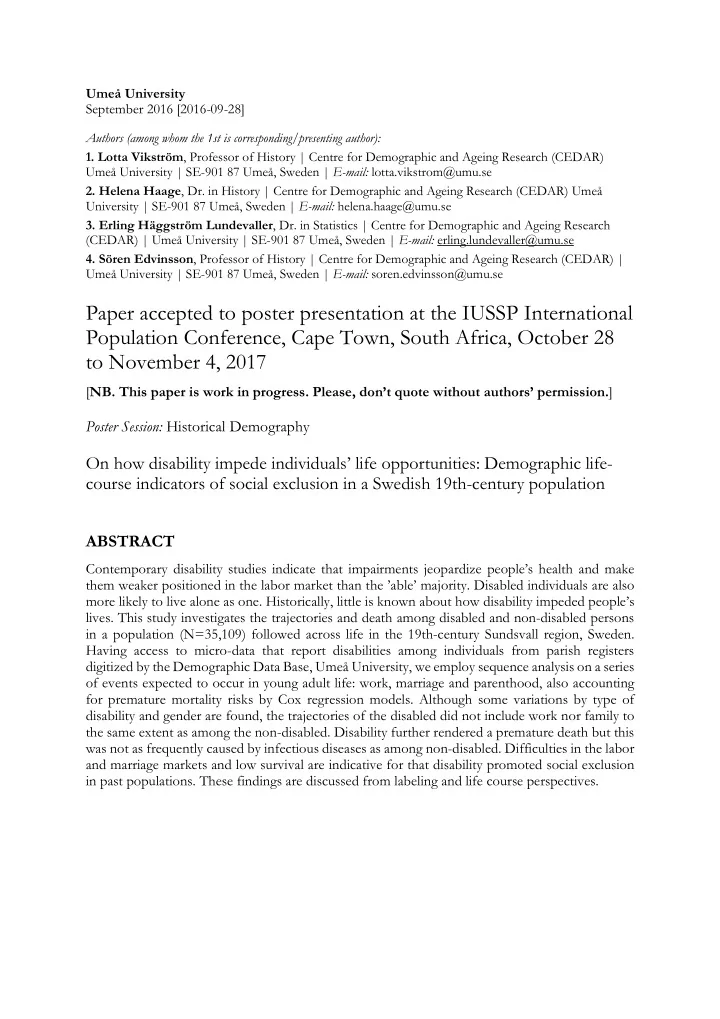

Umeå University September 2016 [2016-09-28] Authors (among whom the 1st is corresponding/presenting author): 1. Lotta Vikström , Professor of History | Centre for Demographic and Ageing Research (CEDAR) Umeå University | SE-901 87 Umeå, Sweden | E-mail: lotta.vikstrom@umu.se 2. Helena Haage , Dr. in History | Centre for Demographic and Ageing Research (CEDAR) Umeå University | SE-901 87 Umeå, Sweden | E-mail: helena.haage@umu.se 3. Erling Häggström Lundevaller , Dr. in Statistics | Centre for Demographic and Ageing Research (CEDAR) | Umeå University | SE-901 87 Umeå, Sweden | E-mail: erling.lundevaller@umu.se 4. Sören Edvinsson , Professor of History | Centre for Demographic and Ageing Research (CEDAR) | Umeå University | SE-901 87 Umeå, Sweden | E-mail: soren.edvinsson@umu.se Paper accepted to poster presentation at the IUSSP International Population Conference, Cape Town, South Africa, October 28 to November 4, 2017 [ NB. This paper is work in progress. Please, don’t quote without authors’ permission. ] Poster Session: Historical Demography On how disability impede individuals’ life opportunities: Demographic life- course indicators of social exclusion in a Swedish 19th-century population ABSTRACT Contemporary disability studies indicate that impairments jeopardize people’s health and make them weaker positioned in the labor market than the ’able’ majority. Disabled individuals are also more likely to live alone as one. Historically, little is known about how disability impeded people’s lives. This study investigates the trajectories and death among disabled and non-disabled persons in a population (N=35,109) followed across life in the 19th-century Sundsvall region, Sweden. Having access to micro-data that report disabilities among individuals from parish registers digitized by the Demographic Data Base, Umeå University, we employ sequence analysis on a series of events expected to occur in young adult life: work, marriage and parenthood, also accounting for premature mortality risks by Cox regression models. Although some variations by type of disability and gender are found, the trajectories of the disabled did not include work nor family to the same extent as among the non-disabled. Disability further rendered a premature death but this was not as frequently caused by infectious diseases as among non-disabled. Difficulties in the labor and marriage markets and low survival are indicative for that disability promoted social exclusion in past populations. These findings are discussed from labeling and life course perspectives.
Vikström et al, ‘On how disabilities impede individuals’ life opportunities’ 1. Introduction: aims and rationales of the study From contemporary disability studies, we know that impairments tend to jeopardize individuals’ health status and that disabled people run the risk of constituting the ‘otherness’ in society (Mont 2007, Priestley 2004; Susman 1994; Jaeger & Bowman 2005; Kudlick 2003; Solvang 2000). In history, most disability studies concern institutionalized individuals for whom the sources tell little about their lives beyond institution; and if the sources do, they usually document only a few persons with disabilities (Förhammar and Nelson 2004). The research design and data of this paper enable us to analyze the life courses of a considerably large quantity of disabled persons and to compare the findings with a group of non-disabled. As a result, we can answer three major questions: 1) Did disability imply higher premature mortality risks for individuals and did these risks differ between type of disability and gender? 2) Did the death causes vary substantially if disability was present in life? 3) Do we find any explanation as to why individuals’ lives eventually ended in untimely death by comparing the life trajectories of disabled and non-disabled men and women? Answering these questions, our primary aim is to advance the knowledge on whether and how disabilities impeded people’s opportunities in history. Studying the life and death of disabled people are important as they have been a minority long hidden in history. Their demographic experiences reflect not only their living conditions but also the attitudes of the majority population in past societies. The results are obtained by employing two types of life course methods: event history analyses (EHA) and sequence analyses (SA). Being able to conduct such analyses of a population showing disabilities about 150-200 years ago, makes our investigation novel in its approach. We have used 19th-century parish registers from Sweden, which allow us to research disabled people’s demographic experiences. These registers are digitized by the Demographic Data Base (DDB) at Umeå University in Sweden, and have not yet been explored systematically from a disability perspective. As the registers are recorded longitudinally, we can follow disabled people over time and obtain data on them. The disabilities chosen to identify disabled people in this study are those labeled ‘blind’, ‘deaf mute’, ‘crippled’, ‘idiot’ and ‘insane’ by the ministers in the parishes. While these concepts may be offensive, due to the derogatory meaning they carry today, we have no intention to offend readers in the few cases we use them. The DDB digitization further enables us to supplement the dataset with a reference group of individuals who do not have any of these selected disabilities. The people in the reference group lived in the same time-space context as the disabled individuals, made up by the 19th-century Sundsvall region in Sweden. 2. Previous research: Mortality patterns and disability in the past From the 18th century onward, mortality patterns have been investigated through both macro and micro studies, especially in the Western world (Bengtsson et al. 2004). These studies demonstrate gendered variations in mortality across different time-space contexts and age groups. Tabular Commission ( Tabellverket ) started with population statistics in 1749 (Sköld 2001), and since then we can see that the mortality among Swedish men has been higher than that among women, except for some brief time periods and mainly among young people (Willner 1999). This male excess in mortality persisted throughout the 19th century although the gap between the genders decreased. During the latter part of the century, improving social, working and housing conditions promoted individuals’ longevity, particularly the men’s, as the gendered gap in mortality continued to decrease. Explanations for this gap in life expectancy have been discussed among scholars, some 2
Recommend
More recommend